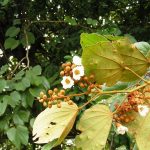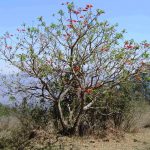TREE LIFE
March 1988
HARARE CALENDAR
Tuesday 1st March: Botanic Garden walk. Meet in the Car Park at 4.45 for 5 pm.
Sunday 20th March: Outing to Ijapo Estate, Chegutu. This month, we are pleased to be joining our very enthusiastic crowd of Chegutu members for an outing to Roger Green’s Ijepo Estate. We visited this venue a few years ago, and although I sadly missed the trip, I believe that last trip was richly rewarding. The area is a fascinating mixture as the Highveld is infiltrated by Lowveld and Zambezi vegetation via the rivers snaking up from the valley. This time I will not miss out. An Express motorways coach has been arranged. (and this time I’ll ensure there are no hitches) It will depart Monomatapa Car Park at 7.30 am. Security guard arranged. Fare $19,00. Please, book with Joy Killian an Harare 308398.
Saturday 26th March: Mukuvisi Woodlands meeting. Meet at 3.30 p.m. at Paget Road/Inyanga Crescent gate.
A Tuesday 5th April: Botanic Garden Walk at 4.45 for 5 p.m.
Sunday 17th April: Outing to Henry Hallam Dam taking own vehicles. Details in next Tree Life .
MATABELELAND CALENDAR
We have been invited, on Sunday March 6th, to go to the Christian Brothers College, to identify their trees, and to assist in marking them with their machine. After which, they will kindly entertain us with a braai and wine. As this only starts at 11.00 am we will first go to Mabukuwsni. Meet there at 8.30 am.
On Sunday, February 7th we went to the Matopos with our usual guide. After lunch we had our long overdue Annual General Meeting. So we are now legitimised with a minimum of officials: Chairman, Mr K E Blake,. Hon. Treasurer, Miss B M.Blake, Hon. Secretary; Mr C Sykes, Committee Member (and Chief Guide) G.G. Archer.
Tree-wise, we also had an excellent day in the Maleme area and beyond – to Nswatugi cave and Mesilume Dam where we lunched.
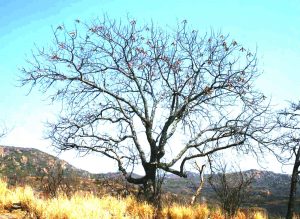
Entandaphragma caudatum. Photo: Bart Wursten. Source: Flora of Zimbabwe
Acacias were few mainly A. rehmanniana, with many A. robusta on the main road in: Acokanthera rotundifolia, Albizia amara, A. antunesiana, A. tanganyicensis, this last Brown paper-bark, conveniently alongside the Green paper-bark Commiphora marlothii.
We saw many Allophylus africana, together with Rhus lancea, R. leptodictya living up to its name Rock Rhus. Pod mahogany – Afzelia quanzensis, many Brachylaena rotundata of the Compositae with a smaller edition in Tarchonanthus camphorates of the RUBIACEAE both gleaming white, Bridelia mollis some with enormous leaves a good 20cm in each direction. We finally located several Cape Chestnut Calodendrum capense flowering well, after having been deceived by many Clerodendrum glabrum in very full flower, Combretum apiculatum, C. erythrophyllum in very dark leaf, Cordia grandicalyx fairly widespread, Croton gratissimus very large leaved, Cussonia arborea, a fine Diplorhynchus condylocarpon, Entandaphragma caudatum under a rather poor specimen of which, Wendy Bullock gave us a good talk on the species; Of Figs we saw Ficus abutilifolia, F. glumosa, F. ingens, F. salicifolia, F. thonningii, Grewia flavescens still flowering Lavender tree, Heteropyxis dehniae, baboons breakfast Hexalobus monopetalus, Homalium dentatum, Kigelia acuminata, Lannea discolor, Lonchocarpus capassa, Maytenus heterophylla, the Matopo subspecies, subsp. puberula. Ochna glauca, Olea europaea, subsp. africana, Pavetta gardeniifolia, P. schumanniana, Pittosporum viridiflorum, Pterocarpus rotundifolius, everywhere, Pterolobium stellatum, Sclerocarya birrea, Strychnos madagscarienses, S. matopensis, Tarenna neurophylla, Trema orientalis, a good ground level view showing the entire leaf margin serrated as opposed to Celtis with only the upper half, 3 Turraea fischeri in full flower, T. obtusifolia and T. nilotica and some good big Ziziphus mucronata in full flower.
-C. SYKES
BOTANIC GARDEN WALK – 2nd February. Just to prove that I have not forgotten, this was well and truly rained out.
Inspired by the article in last month’s Tree Life on “First, steps in the process of identification“ I have decided that “no longer will Tree Sunday be a leisurely stroll in the sunshine – enjoyini the sounds and sights of the bush” listening with half an ear to the words of those learned persons who know all about trees, but it will be a careful observation of the leaves, the bark, the shape and all the points necessary to identify a tree.
Saffron Walden was a wise choice in this variable weather and in the event we had a rain free day although towards afternoon it became very hot and humid. We are grateful to Mrs. Hinds for giving us permission to explore the beautiful granite kopjes on the farm. Kopjes are always exciting, apart from all the old tree friends we can expect to be growing on the granite sandy soil there also may be a Bushman painting – but why did those little San people so seldom paint trees or plants or aloes. Were they so engrossed in subsisting that only the awesome spirits and hunting for food mattered ? I wonder if among the many paintings on the farms of our farmer members there are some with trees depicted. Dick, our Chairman, told us that there was in fact a painting on the top of the kopje we climbed, but our party became so engrossed in trees that we did not reach the top to look for it.
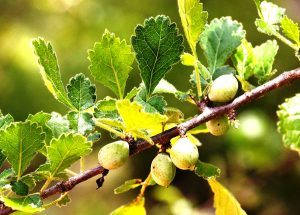
Commiphora africana. Photo: Bart Wursten. Source: Flora of Zimbabwe
At this time of year there are few flowers and very little fruit in evidence, and identification is not easy – so leaves and bark become all important. Our first find was an unusually large Grewia monticola causing little doubt as the serrated asymmetrical leaves, harsh on top and smooth and pale below, were most obviously indicative of the species. This tree’s stem was round as were the branches but in other species the branches are squarish. There are twenty-three species of Grewia in Zimbabwe and the leaves do play a most important part (apart from the fruit) in identification. Close by was a Commiphora africana, the first of the trifoliate trees we found, with definitely scalloped margins and a softly hairy surface. Commiphora means gum bearing and amongst all the small green fruit on the tree we found one which when split open revealed a red aril amongst the oozing sticky fluid, which is eaten and is very popular with hornbills. This tree is often confused with Rhus tenuinervis with much the same leaves but very different bark and fruit.
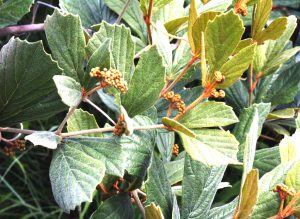
Rhoicissus tridentata. Photo: Bart Wursten. Source: Flora of Zimbabwe
A more unusual one now – a member of the grape family VITACEAE; Rhoicissus tridentata with long tendrils and little bunches of “grapes”. A sure aid to identification were the arthritic swollen joints and distinct dentations in the margins of the leaves. The next find, Turraea nilotica (local woodland mahogany) was most interesting, because it is of the MELIACEAE family and we were able to compare it with some members of the RUBIACEAE family which it resembles very closely. They flower at the same time. The large densely hairy leaves are slightly alternate and a sure give-away is that they look as though someone has pulled a draw string giving a curly appearance to the leaves. Later on we examined Vangueriopsis lanciflora and found that the very similar leaves are opposite with the unmistakable interpetiolar stipule, (RUBIACEAE). We also found a Vangueria infausta with the tells-tale stipule but deeply infested with a virus which is never found on V. lancifolia. Identification at a quick glance is the very characteristic reddish brown surface of the younger branches not evident in the Turrea.
The unmistakable interpetiolar stipule, (RUBIACEAE). We also found a Vangueria infausta with the tells-tale stipule but deeply infested with a virus which is never found on V. lancifolia. Identification at a quick glance is the very characteristic reddish brown surface of the younger branches not evident in the Turrea.
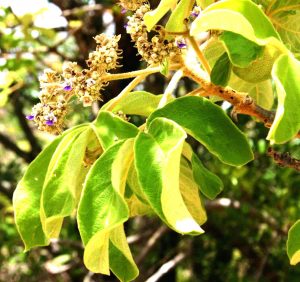
Vitex payos. Photo: Bart Wursten. Source: Flora of Zimbabwe
The next one was a fun tree because you can if you wish pick the leaves and stick them all over you, Pouzolzia mixta, previously hypoleuca, the soap nettle. So to the first of the palmate trees, Vitex payos (the chocolate berry) with its unmistakable palmate compound leaves. The general shape is also rather characteristic, looking rather like an umbrella; the berries were green so we were not able to taste them but when ripe they do look and taste like chocolate. Later on we were to see a rather poor specimen of Cussonia arborea (octopus cabbage tree) also with digitately palmate leaves, but with a corky bark and unusual slender spiky flowers which remain in groups on the tree for a long time.
Another edible fruit – that of the Azanza garckeana (the snot apple). No problem here – the leaves are stellate, star-shaped and hard and hairy with a rather unusual venetian of the veins going round in a digitate manner and of course the tell-tale gland on the midrib on the under surface. There were no fruit to sample but we did find a yellow/black/red spotted caterpillar feasting on the leaves. Two types of cassia were found – Cassia abbreviata and C, singueana both with compound pinnate opposite leaves but no flowers to tell the difference. On the C. abbreviata there were long cylindrical green pods with a soft velvety covering not yet turned to black and on the C. singueana the little “bee-stings” (more correctly stipitate glands) on the branches. Even when dry and there are no leaves the bee stings can be seen.
Bark can be very important – standing in splendid isolation was a tall slim tree with dark grey deeply reticulated fissured bark, quite outstanding – Ochna schweinfurthiana. We all know the “mermaid tree”. Ochna pulchra with its rough grayish bark flaking to reveal a creamy white smooth under bark; so it is easy to identify both species. There is a third tree species of Ochna in the area, the O. puberula with leaves similar to those of schweinfurthiana but much smaller – and we were fortunate to find one near the top of the kopje. The thing to remember about Ochnas is that the midrib of the leaf protrudes on both sides of the leaf in all species.
In a shady glade amongst the granite rocks there was a group of Afzelia quanzensis (pod mahogany). Phil thought this might be a good spot for lunch until we discovered a large bed of nettles there. These pod mahoganies are tall spreading trees with quite a distinctive greyish-brown bark flaking in roundish woody scales and I remember seeing the one-petalled red flower on one of our trips. The seeds are relished by horn-bills and valued by humans for necklaces as they are black with a scarlet aril enveloping the lower third. The Zulu name for the tree is lovely – “Mkehli” and it means ‘betrothed girl’ for the black seed with its red aril suggests the head of a maiden with the red-ochred head-dress worn in the period prior to her marriage.
Several species of Rhus were evident but the unusual one was Rhus leptodictya common on granite hills and which grew in profusion. The leaves are long and thin, trifoliate slightly serrated and fairly pale green and with the usual smell indicative of Rhus. Acacias are extremely irritating – they have so many relations and at first glance they all look alike with fuzzy heads. So only to look carefully for thorns or spiky branchlets will give you the clue, unless they are flowering. Within close proximity we found two-tall acacias and on checking these clues found they were Acacia sieberiana with straight spines and slightly corky bark and A. polyacantha, with hooked spines and woody bosses on the trunk, yet at a distance they looked the same. The Ficus family, too, is vast and varied; we found Ficus thonningii which had us puzzled for a while until we found some very small fruit, and the F. sycomorous unmistakable with its yellow green bark and much larger fruit. I was interested to learn that the Ficus family is of the MORACEAE group (mulberry). Why – can you imagine a fig turned inside out – does it not resemble a mulberry?
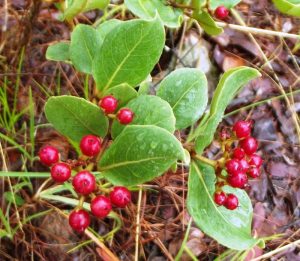
Psorospermum febrifugum. Photo: Bart Wursten. Source: Flora of Zimbabwe
All these and many more – but on the way down we made a most exciting find, a Euphorbia matabelensis. This tree does not resemble any other Euphorbia (the leaves grow in fascicled rosettes) but has a most definite zigzag patterned branch (hence the name “zigzag” tree). On breaking a branch there was the typical milky latex of the Euphorbia. The Flacourtia indica were in heavy fruit, not yet ripe, but even in the green state we could see the apex of the fruit which is always offset slightly. And the Zimbabwe “holly” Psorospermum febrifugum, had masses of bright red berries, a little late for the festive season.
After lunch amidst all those granite rocks and trees, we walked down the road in the open woodland and found a little in addition to what we had seen in the morning. The Kigelia africana with their large leaves and even larger green sausages hanging from long stems were much in evidence and the Terminalia sericea were starting to show off their reddish-brown pods which on mass are so spectacular and attractive. We left after tea and were amused as we drove out of the farm gate to see three hairy sentinels sitting on top of the highest outcrop seeing us off the premises.
This has been hard work – so perhaps next Tree Sunday I will again enjoy a leisurely stroll in the sunshine listening with half an ear to the words of these learned persons – – – –
-V. Siebert
“TEN TREE” SECTION
He never did find the Rock paintings! There was speculation that they’d been pinched and sold, but the truth lay in the Chairman’s bump of locality or lack of it. Sorry, folks!
We found several other things. We found that we were a little fitter than we thought we were, and we found muscles where we’d forgotten they existed. And, of course, we found a selection of trees which seem to enjoy growing on granite kopjes. Diospyros natalensis, with its small, shiny dark green leaves about the size of a tickey, Commiphora marlothii smooth, green, and paper peeling, both seemed to thrive on whatever they had found in narrow cracks in the rocks. Garcinia buchananii showed plenty of yellow sap when the leaves were folded, no doubt the plentiful rain had something to do with this, as it is sometimes hard to see. Erythroxylum emarginatum had a brave show of crimson fruit, as did Psorospermum febrifugum, a little late for Christmas, maybe, but a joy to find none the less. One that foxed us was later identified as Nuxia congesta, with leaves in whorls of three and sometimes a centre vein on the leaf that tended to zig-zag. A reminder of dark satanic mills was provided by Euclea natalensis, looking as though it had been dusted with a shower of smut from a factory chimney. Also dusted, apparently with rust from a scrap-iron yard, was Rhoicissus revoilii scrambling its way to the sun and using anything it could find to help other trees, rocks, you name it. A new one to most of us was Psydrax livida, if for no other reason than it was known as Canthium huillense until fairly recently.
So who cares about Rock paintings.
Sunday, 17th January 1988 – Buckland Estate
(My apologies to Dick and his fan-club for having left this out of the last newsletter. Pure oversight I assure you.) Things got out of line from the start.
This happened because the Mentor wished to drive home the point that one doesn’t need acres of bush to find the enjoyment of trees. A modest clump of trees was selected – it would have fitted easily into half a tennis court. In it were found Diospyros lycioides, Flacourtia indica, Cussonia arborea with flowers like an advertisement for a Calamari Take-away, Bauhinia thonningii, Rhus longipes, Ziziphus mucronata, a very hostile-looking Maytenus heterophylla and a very dense Maytenus senegalensis. Well, that was eight species in about twenty minutes.
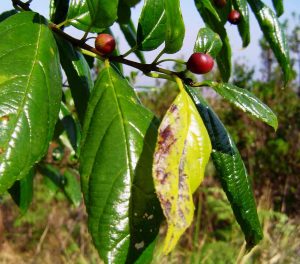
Rhamnus prinioides. Bart Wursten. Source: Flora of Zimbabwe
We moved on for another few yards made the acquaintance of Maesa lanceolata with its brown sap and the lovely shiny leaves and red berries of Rhamnus prunoides.
The Mentor was now looking at his watch and wondering what to do for the rest of the day. Perhaps we could go on to the vlei and gather mushrooms? Or perhaps we could take up the suggestion of Janice Blue, of the Centre European de la Nishiran shoshu, who has written to the Society with the idea that we should chant NAM MYOHCI RENGE KYD, a Buddhist world peace chant?
Suddenly, Kim Damstra emerged from the bush, festooned with Haxen young, and our troubles were over. He banished our mental agony as to whether or not the fig that confronted us was F. glumosa by pointing out the shiny green patches in the junctions of the main vein and the first pair of lateral veins. These are distinctive only to F. sur, F. sycamorus and F. vallis-choudae.
And so we said farewell to Syzygium cordatum to Vernonia subuligera and V. amygdalina to the male and female flowers of Bauhinia thonningii and to host of others and we followed the magical path of botanical fact that Kim manages to blaze every time.
-Dick Hicks
ALOE 88 IN JULY 1988
The Aloe Cactus & Succulent Society of Zimbabwe is planning its Second International Succulent Plant Congress 9 Aloe 88 – in Zimbabwe in July 1988. The firm programme is to have a week of illustrated lectures in our Capital City of Harare by the world’s leading succulent plant authorities from Monday 18th July to Saturday 23rd Jul 1988, preceded by our internationally acclaimed National Aloe, Cactus and Succulent Show and Plant Sale from Friday 15th to Sunday 17th July 1988.
Subject to confirmation and demand this will be followed by a five or six day official tour from Monday 25th to Friday 29th July 1988 encompassing the wonderful Victoria Falls and the famous Hwange Game Reserve, as well as field tours and – photo safaris in the incredible Hwange area to the habitats of Euphorbia cooperi variety cooperi, cooperi variety calidicola, ingens, fortissimo, sapinosa, transvaalensis, persistentifolia, malevola, etc of several Aloe species; of various stapeliads and of some interesting caudiciform plants such as Fockea multiflora and augustifolia, and several Raphionacma and Pterodiscus spp., as well as Adenium obesum, several Adenia and Ceropeqia spp., Sanseveria, Brachystelma, Talinum and Cissus.
LOCAL HABITAT TOURS AND PHOTO SAFARIS DURING ALOE 88
During the week of lectures we will have an outing to the fantastic Great Dyke (60 miles or 96‘ kilometres from Harare) to view several endemic species such as Euphorbia memoralisa, Euphorbia wildii and Aloe ortholopha in habitat as well as Aloe cryptopoda, Euphorbiaspinzia, a Raphionesme or two and a new undescribed species of Jatropha. Also we will try and find time to visit the long established Ewanrigg Botanic gardens (aloes, euphorbias, cycads, cactuses, etc.) The outstanding National Botanic Gardens with its 700 different species of Zimbabwean trees, and an extensive private garden which has probably the largest and most comprehensive cycad collection in the world as well as a wide range of mature succulent plants.
REGISTRATION FOR ALOE 88
If any members of the Tree Society are interested in the aforegoing please write for a registration form to the Convener of Aloe 88, P 0 Box 8514, Causeway, Harare, Zimbabwe; We expect a rush to register and as we cannot accommodate more than 400 delegates please apply early to avoid disappointment. All applications will be dealt with on a first come first served basis.
OUTWARD BOUND ZIMBABWE we have received a letter from Gordon Poultney, responsible for Marketing and Promotion for the above follows: You will see from our program for 1988 that we have planned a Horizon Natural History course commencing on 2nd April and lasting eight days. As in the previous days of operation, this course is open to anybody who has an interest in flora and fauna and who would like to spend some time in the Chimanimani area looking at its natural beauty. We are sure that this course will be of interest to some of your members and would be grateful if you would publicize it accordingly. In addition we would welcome any input from your society in regard to the actual operation of the course – we are currently in touch with Mr Muller of the National Botanic Gardens who has agreed in principle to provide an expert, but any other help would be of tremendous benefit. If you require any further information please do not hesitate to contact me direct on 702665.
-Dick Hicks Chairman


